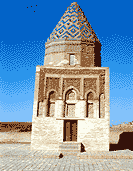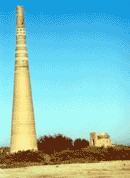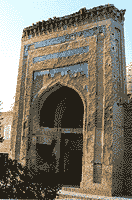Kone Urgench Historical Site
Topic: Travel to Turkmenistan

At the far end of Turkmenistan, 150 km to the northwest of Dashoguz, lies Koneurgench City (population 31.400). The outskirts of the city adjoin the territory of the State Historical -Cultural Museum - Reserve, covering nearly 640 hectares, and was founded in 1985. Here one can find several magnificent architectural memorials of the 13th - 14th c. These include one of the tallest minaret in Middle Asia, and various numbers of common buildings in medieval epoch: mausoleums, medressas and fortresses.
There are all remnants of the ancient capital that gained prosperity thousands of year ago. It was the ancient capital of Khorezm, a historical region located near the mouth of Amu-Darya River, the first mentioned in the famous Behistun legend of Tsar Dary I (the 6th-5th c AD) and also in the "Avesta" - Zoroastrians' sacred book.
No one knows when Koneurgench was founded. Traces of an ancient settlement were discovered recently on the territory of present Koneurgench. During the excavation of a barrow, called Kyrkmolla, contours of a powerful antique fortress were found, based on earlier cultural ground with ceramics of 6th - 7th c AD.
In 712, Khorezm was overthrown by the Arabs, and Koneurgench took its Arabic name Dgurdganiya (or Gurgandj). The city developed, thanks to its advance position on the trade routes from the south to the north and from the west to the Volga River, and to the east in Mongolia and China.
In 995, Gurgandj become Khorezmshakh's state capital and the second city after remarkable Bukhara - capital of Samanids, in Middle Asia. It is amazing that wonderful architectural monuments from that era have survived. The earliest among these are mausoleums of Khorezmshakhs II - Arslan and Tekesh, built in the 12th c. The city was surrounded by walls - fragments of which form a bank. There are another monuments such as the most beautiful palace in Gurganj Turabek - Khanum (dated originally in the 12th century and was considered to be a mausoleum of the Sufi Dynasty); Kutlug - Timur minaret; Mamun II minaret; Sultan Ali mausoleum; Ibn - Khadgib mausoleum (14th century); Ali Ar - Ramitany mausoleum (Ezizdgan); Seyid Akhmed mausoleum; portal of an unknown monumental construction ("Peshtak" of Caravansaray - 14th century); Nadgmetdin al - Kubr khanaka; burial building - Mukhamad Karim - Ishan mausoleum (1886 - 89); medressa "Dash - masque" (1907-1908).On the Koneurgench territory there are preserved numerous archaeological and architectural monuments, presenting considerable scientific and cultural value. Kone Urgench has been known by various names, found in Avesta-Urva (VI c. BC); Hangrid-Hanjird (VII-VIII c.c. AD); Gurgench-Djurdjaniya (XI-XII c.c. AD). After the Mongol invasion, the town was called Urgench; from l646 AD, it was known as Kone-Urgench.

Ancient Kone-Urgench was considered one of the major cities of the East. The scientists who studied the topography of Gurgench/Urgench considered that the territory was as large as 1000 hectares in the X-XIV c.c. AD. This site is presently protected by the Government. It occupies 640 hectares. Legend tells that the town Kine-Urgench was destroyed and re-built seven times. Beginning 1681 AD, Kone Urgench came under the control of Arab rules. Between 1017- 1034 AD , Kone Urgench was governed by Ghaznavids. Abu-shtegin, a turkish slave, founded a new state which lasted until 1221 AD. In 1221 Urgench was destroyed by the Mongols. In 1321, the town was annexed to the Golden Horde. In the middle of the 14 c. Hussein Sufi, a Qongart Turk, founded the Sufi Dynasty with the support of the Khan of the Golden Horde. In 1388 the town was destroyed by Temur Link, and lost a status of a city. In 1646, when the Amu-Darya river changed its course, life stopped here. After the construction of the canal Khanyap by the Khans of Khiva, the town was re-born.
Kyrk Molla The fortress Kyrk Molla is located in the north-eastern outskirts of Gur-Gench, and dates back to the X-XIV c.c.. It is directly to the north east of the monument of KHOREZM-shah Tekesh. The height of the fortress is 12 m.
Akk Gala This fortress is located southwest of the ruins of Medieval Urgench. Their high walls, built with sun dried bricks, have survived to our days. Historical references indicate that the famous "Koshk-l-Ahchas", dating back to the X-XII c.c., was located here. The height of the walls of the fortress ranges from 6 to 8 metres.
Dashgala Dashgala begins from the canal "Gushbegiyap" which runs to the south of the mausoleum ll'Arslan. It borders Ak Gala on the east and Khorezm Bagh on the west. Dashgala is surrounded by a moat. Inside the Dashgala, there are such monuments as Karavansaray in the south and the Minaret of Mamum in the north.
Mausoleum of Soltan TekeshThe monument known as Soltan Tekesh is located to the southeast of Kyrk Molla. Soltan Tekesh ruled between XII-XIII c.c., Although in the scientific literature this structure is known as the Mausoleum of Tekesh, in popular parlance called Gokgummez (Blue cupola) or the Mausoleum of Shyh Sherip Baba. The foundation of the monument is quadrangular in shape, and the 24-sided cupola is 18 meters high with a square base measuring 11.45X11.45 m.
 II Arslan
II Arslan II Arslan is a magnificent building, located between Dashgala and the Mausoleum of Tekesh. This magnificent structure is known among the people as Mausoleum of Kho-rezmshah II Arslan. The monument is also named after the famous Islamic scientist and philosopher Fahreddin Razi. II Arslan ruled from 1156 to 1172. According to the latest scientific theories, this building was used for storing water.
Monument of Torebeg HanumThis monument, named after Torebeghanum, is located in the northern part of the ancient Gurgench. This monument con-sidered to be the most beautiful in Central Asia. Torebeg-haanym dates back to the end of the XIIc. - begining of the XIII c. Some historians doesn't consider it to be a mausoleum, but rather the palace of the Anushtegyns Dynasty. This structure, with a total area of 100 sq. m and high portal /25 m., is divided into three parts. It consists of a large central hall, a watchtower on the left and a staircase of 45 steps on the right.
 Minaret of Gutlugh Temur/XI-XII c.c.
Minaret of Gutlugh Temur/XI-XII c.c.The minaret of Gutlugh Temur is located in the north west side of Khorezmshakh Tekesh. It is 64m high and considered to be the highest in Central Asia. The diameter of foundation is about 12 m., the diameter of the top is about 2 m. At a height of 7 m there is an entrance into the minaret .
Caravansaray/X-XII c.c.The monument, known as Caravansaray, is located in the south of ancient Gurgench. According to historians , ancient Gurgench had had three gates: Akabilan, Nowur and AI-Kauz. Caravansaray is rectangular in shape and measures 34 m from north to east.
Nedjmeddin Kubra
The monument of Nedjimeddin Kubra is located in the western part of Kone Urgench. The monument is named after Ahmed ibn Omar Abuidjenap Nedjimeddin al Kubra al Khorezmi. He was born in Urgench in 1145-46, and became the founder of the Kubravid's school of Sophism. Nedjmeddin Kubra was famous not only as philosopher, but also as a painter, physician, chess master and talented general. Seven books and 24 rubais written by Kubra survived to this day. This monument is a perfect architectural construction. Its portal dates back to the XII-XIII c.c.. The monument was rebuilt during the era of prosperity of Khorezm, and again after the Mongol invasion.
Piryarweli The mausoleum of Piryarweli is located to the west of Nedjmeddin Kubra.In this place a lot of famous people were buried,such as Shyh Setdar, Sheker Gendji, Daniyar Weli. Piryarweli was a contemporary of Nedjmeddin Kubra. Initially the monument was costructed in the XII-XIV c.c.. The height of its portal is 6.5 m and length is 7.5 m.
Ibn Hadjib The monument of Ibn Hadjib, located in the western sector of ancient Gurgench, was built in honor of Ibn Hadjib, a talented descile of Nedjmeddin Kabra. This monument is actually a complex, different parts of which were constructed in different periods of time/ 14,18,19 c.c. This includes a burial chamber and premises for the visitors.
Mausoleum of Seyit Ahmet/XIV c. The grave of Seyit Ahmet is located on the right side of the road to Minara. Seyit Ahmet was a famous contemporary of Nedjmeddin Kubra.
Soltan AliThe mausoleum of Soltan Ali is located on the opposite side from the mausoleum of Nedjmeddin Kubra.This monument is linked to the name of Soltan Ali, who ruled Urgench in the 16 c. The monument is hexagonal in shape. The diameter of the cupola is 9.5 m.
Located along the famous Silk Road, Kone Urgench became an important link for the caravans, passing from the East, West and North , from the Volga river, Mongolia and China. This crossroad was a great contribution to the development of science and culture in Central Asia.
Source: StanTours
Posted by countryturkmenistan
at 4:33 PM
Updated: Wednesday, 27 July 2005 5:15 PM
 9 June, 2005. Malaysian state oil company Petronas that has been prospecting the Turkmen sector of the Caspian sea since 1996, plans to invest over $210 million in this area, the Turkmen government official told Reuters.
9 June, 2005. Malaysian state oil company Petronas that has been prospecting the Turkmen sector of the Caspian sea since 1996, plans to invest over $210 million in this area, the Turkmen government official told Reuters. 
 "A PRICELESS PEARL IN TURKMEN ART TREASURY”
"A PRICELESS PEARL IN TURKMEN ART TREASURY” At the far end of Turkmenistan, 150 km to the northwest of Dashoguz, lies Koneurgench City (population 31.400). The outskirts of the city adjoin the territory of the State Historical -Cultural Museum - Reserve, covering nearly 640 hectares, and was founded in 1985. Here one can find several magnificent architectural memorials of the 13th - 14th c. These include one of the tallest minaret in Middle Asia, and various numbers of common buildings in medieval epoch: mausoleums, medressas and fortresses.
At the far end of Turkmenistan, 150 km to the northwest of Dashoguz, lies Koneurgench City (population 31.400). The outskirts of the city adjoin the territory of the State Historical -Cultural Museum - Reserve, covering nearly 640 hectares, and was founded in 1985. Here one can find several magnificent architectural memorials of the 13th - 14th c. These include one of the tallest minaret in Middle Asia, and various numbers of common buildings in medieval epoch: mausoleums, medressas and fortresses.  Ancient Kone-Urgench was considered one of the major cities of the East. The scientists who studied the topography of Gurgench/Urgench considered that the territory was as large as 1000 hectares in the X-XIV c.c. AD. This site is presently protected by the Government. It occupies 640 hectares. Legend tells that the town Kine-Urgench was destroyed and re-built seven times. Beginning 1681 AD, Kone Urgench came under the control of Arab rules. Between 1017- 1034 AD , Kone Urgench was governed by Ghaznavids. Abu-shtegin, a turkish slave, founded a new state which lasted until 1221 AD. In 1221 Urgench was destroyed by the Mongols. In 1321, the town was annexed to the Golden Horde. In the middle of the 14 c. Hussein Sufi, a Qongart Turk, founded the Sufi Dynasty with the support of the Khan of the Golden Horde. In 1388 the town was destroyed by Temur Link, and lost a status of a city. In 1646, when the Amu-Darya river changed its course, life stopped here. After the construction of the canal Khanyap by the Khans of Khiva, the town was re-born.
Ancient Kone-Urgench was considered one of the major cities of the East. The scientists who studied the topography of Gurgench/Urgench considered that the territory was as large as 1000 hectares in the X-XIV c.c. AD. This site is presently protected by the Government. It occupies 640 hectares. Legend tells that the town Kine-Urgench was destroyed and re-built seven times. Beginning 1681 AD, Kone Urgench came under the control of Arab rules. Between 1017- 1034 AD , Kone Urgench was governed by Ghaznavids. Abu-shtegin, a turkish slave, founded a new state which lasted until 1221 AD. In 1221 Urgench was destroyed by the Mongols. In 1321, the town was annexed to the Golden Horde. In the middle of the 14 c. Hussein Sufi, a Qongart Turk, founded the Sufi Dynasty with the support of the Khan of the Golden Horde. In 1388 the town was destroyed by Temur Link, and lost a status of a city. In 1646, when the Amu-Darya river changed its course, life stopped here. After the construction of the canal Khanyap by the Khans of Khiva, the town was re-born.  II Arslan
II Arslan  Minaret of Gutlugh Temur/XI-XII c.c.
Minaret of Gutlugh Temur/XI-XII c.c. The monument of Nedjimeddin Kubra is located in the western part of Kone Urgench. The monument is named after Ahmed ibn Omar Abuidjenap Nedjimeddin al Kubra al Khorezmi. He was born in Urgench in 1145-46, and became the founder of the Kubravid's school of Sophism. Nedjmeddin Kubra was famous not only as philosopher, but also as a painter, physician, chess master and talented general. Seven books and 24 rubais written by Kubra survived to this day. This monument is a perfect architectural construction. Its portal dates back to the XII-XIII c.c.. The monument was rebuilt during the era of prosperity of Khorezm, and again after the Mongol invasion.
The monument of Nedjimeddin Kubra is located in the western part of Kone Urgench. The monument is named after Ahmed ibn Omar Abuidjenap Nedjimeddin al Kubra al Khorezmi. He was born in Urgench in 1145-46, and became the founder of the Kubravid's school of Sophism. Nedjmeddin Kubra was famous not only as philosopher, but also as a painter, physician, chess master and talented general. Seven books and 24 rubais written by Kubra survived to this day. This monument is a perfect architectural construction. Its portal dates back to the XII-XIII c.c.. The monument was rebuilt during the era of prosperity of Khorezm, and again after the Mongol invasion.